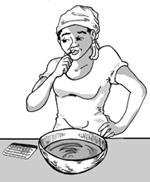Chapter 2 Download Chapter
Explaining How to Use
| 1. Give pills |
|
| 2. Explain pill pack |
|
| 3. Give key instruction | 
|
| 4. Explain starting next pack |
|
| 5. Provide backup method and explain use |
|
| 6. Explain that effectiveness decreases when breastfeeding stops |
|